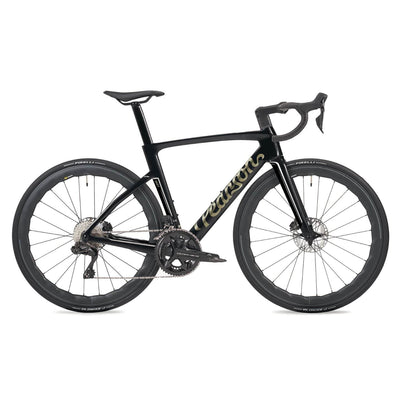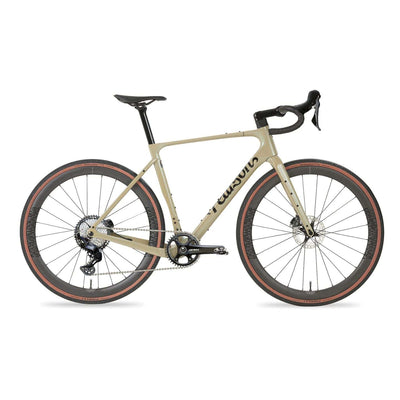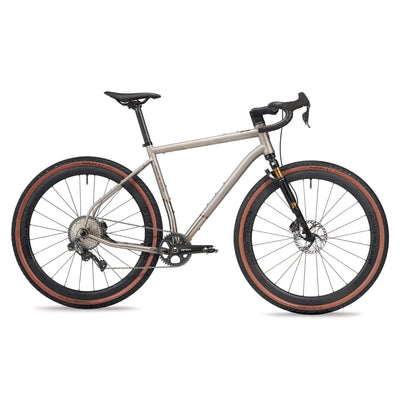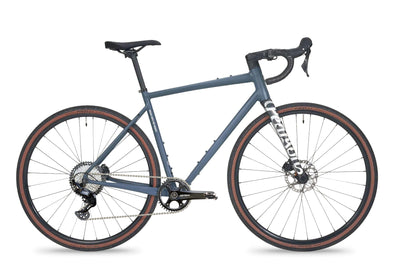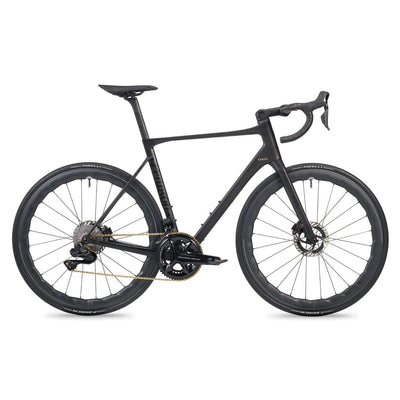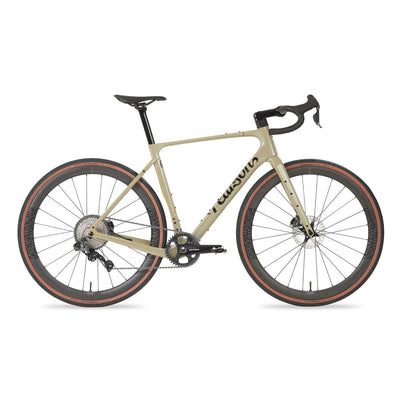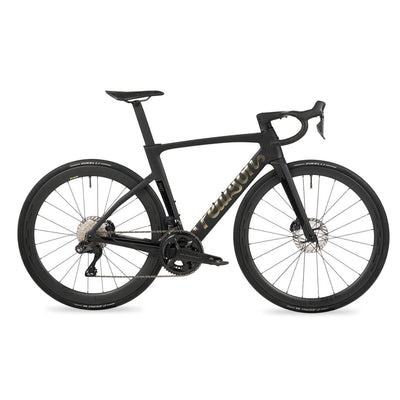Guide to bikepacking: what to ride and what to take
Heading off for a few days on your bike is a great opportunity to get off the beaten track and explore new areas a bit further afield. A bikepacking trip lets you travel light and fast. We’ve just launched the ideal bike for bikepacking too.

Preparation and planning are everything when it comes to a successful bikepacking trip - you don’t want to be cycling around frantically trying to hunt down an item you’ve forgotten to pack or trying to get the parts to fix a mechanical.
Fortunately there’s loads of kit available to make it easy to carry all you need without overburdening yourself or your bike. Here’s what you need to know and what you need to pack.
The bike
The right bike for the trip is key. Although you can bikepack on an MTB or, if you’re sticking to tarmac or smoother tracks, use a road bike or a hybrid, a gravel bike is the ideal steed for bikepacking.
That’s because gravel bikes let you get off the beaten path and onto tracks and trails, but still give you enough speed on tarmac and hardpacked trails to travel fast and cover a good distance. They’re also super-sturdy to carry the extra weight of your bikepacking kit and have the stability to cope with the altered centre of gravity, while the wider tyres and relaxed position add comfort to long days in the saddle.

Our latest gravel bike is the Around The Outside and it’s the perfect bike for bikepacking. There’s loads of clearance for 650b wheels and tyres, which add plenty of air volume for grip off road and to cushion out bumps. The robust titanium frame can handle anything you throw at it and there are lots of mounting points for bags and bottles on the frame and the carbon fork legs.
Component options include a Shimano GRX single ring groupset too. With the potential for a 1:1 lowest gear ratio, there’s plenty of range to carry you and your kit up steeper off-road climbs while still letting you press on when you’re on the flat.
Panniers or bikepacking bags?
The traditional way to carry everything you need for a multi-day tour is to use panniers. For longer trips, these usually come in pairs. They’re attached to a metal rack, which is bolted to the bike’s frame. That means you need rack mounting points on your bike - many distance oriented bikes, including gravel bikes, come with these, but not all.
The advantage of panniers is that they place the weight of the luggage low down and hold it pretty firmly, so they’re not going to raise your bike’s centre of mass that much. If you’re going long, you can fit both front and rear panniers for extra capacity. You can lash further gear to the top platform of a rear rack too, or carry a rack bag, and use a bar bag for smaller items, so you can really load up.
The modern trend is to use bikepacking bags though. They have the advantage if you’re heading off-road that they are less likely to catch on obstructions. They’re a more rugged option too. On the other hand, if you’re planning a long distance trip on tarmac, racks and panniers are still a good option and may give you more carrying capacity.
The luggage
Bikepacking bags are designed to strap easily to any bike without needing pannier racks, although some do need mounting points on the frame or fork legs. At Pearson, we stock the Apidura Expedition range of bags, which is first-rate quality and includes bags to strap to pretty much any part of your bike.
The minimum for bikepacking tends to be a large saddle pack and a bar pack. You’ll probably need more than that though unless you plan to travel very light and overnight indoors.
Saddle packs start at around 5 litres and Apidura’s range goes up to 17 litres. Attachment is usually via straps that mount to the saddle rails and one or more that go around the seatpost and there’s usually a roll-down top that keeps out the weather and lets you alter its volume.
Apidura’s bar packs can add up to 14 litres of extra carrying capacity and are designed to be stable but not get in the way of the bar tops.
Additional pack options include a top tube pack. Because it has to be narrow so as not to get in the way when pedalling, this will add only around a litre of capacity, but it’s a good place to stash food or tools.
You can add even more capacity by using a frame pack, which fits in the bike’s front triangle. Again, it needs to be narrow to keep out of the way of your legs, but you can add up to 6 litres with Apidura’s bags, although a bag this large will stop you using your bottle cage mounts.

Many gravel bikes have mounting points on the fork legs too, which let you bolt on extra luggage, and you’ll usually have a third bottle cage mount on the underside of the down tube which can be used for luggage instead of a bottle.
Beyond that you can always carry a backpack, although that can be uncomfortable and you’ll be raising your centre of gravity more than with bike packs.
So there are lots of options to load your bike up for bikepacking, although the lighter you can travel, the faster you’ll go and the more enjoyable the experience will be. Which brings us to…
The gear
There’s a lot to take for a full-on wilderness bikepacking trip, particularly if you’re planning to camp out, although it’s no more than you’d need for a multi-day hiking trip and many brands sell the specialised gear you need.
First off, you’ll need sleeping kit. Down sleeping bags are still the lightest, most compact option, although they’re expensive. Beware of wet conditions, as down can quickly wet out, becoming heavy and losing its insulation properties, although many bags now use down that’s treated to prevent wetting out. A synthetic bag will be bulkier and heavier but cheaper and will stay warmer if it gets wet while a quilt is a minimalist option for warm weather sleeping.
The lightest, most compact option for shelter is a bivy sack. It’s fine for camping out in fair weather, but not so good if the rain sets in. If you’ve got the room or are riding with others, a lightweight tent is a better option - the lightest only weigh a couple of kilos and you can share the burden between you. Just don’t get split up, as once happened to me. I ended up stringing the inner tent between two trees while my companion had to sleep under the fly sheet and poles.
It’s also worth having an inflatable mattress to add a bit of comfort and, importantly, to insulate you from the ground. Again, there are lightweight, compact options available from the likes of Therm-a-Rest and Sea To Summit.
A lightweight stove like those from Jetboil and MSR will let you brew up - both make a coffee plunger to fit too, so you can drink real coffee during your trip. If you’re looking to cook food, you may need a larger model though and you’ll need cutlery to eat it with. If you’re travelling in a group you may need additional bowls or plates to eat from and you’ll need to be able to wash up afterwards too. Sea to Summit makes a collapsible kit that includes a silicone cooking pot. Don’t forget a lighter or matches if your stove doesn’t have an integrated lighter. You may need a spare gas canister too.

If you’re going to wild camp you’ll need loo roll and a trowel. Wet wipes are useful too,although they don’t degrade quickly so carry them to a bin. Don’t forget sunscreen, a small first aid kit, insect repellent and antihistamine cream if you’re sensitive to bites - or your toothbrush.
The food
You’ll need to eat plenty, so look for shops on or close to your route where you can stock up and buy lunch. You also need to be able to carry your food and waste without it getting all over your camping gear, so take a few carrier bags along.
For in-camp food, you can buy dehydrated meals that you just add boiling water to, or there’s the option of self-heating food packs. It may not be very exciting, but camp food is a good way to make sure that you get enough calories to keep you fueled up for the next day. Take some pepper and salt and dried herbs or spices to make it more interesting.
The good thing is that there are lots of options to buy food on all but the most remote trips. You’ll probably be able to find dinner at a pub or cafe, which might also be open for breakfast. On the South Downs, Cadence offers a string of cafes geared to cyclists, for example.

Pack plenty of energy bars and single serving energy drink sackets. Electrolyte tabs are very compact and a good way to keep your salt levels up if it’s hot.
Where to stay
For the most off-grid experience, camping has to be the way to go. Make sure to ask the landowner for permission if you’re going to wild camp though. The alternative is a campsite, which will up your comfort level with loos and showers, as well as ready access to running water, which can be a problem when you’re wild camping. Pack a travel towel or use your cycling clothing to dry off with. In all cases, don’t light fires, clean up after yourself and don’t litter.
In Scotland, you can camp in most unenclosed areas, so there’s a bit more flexibility. There is also a network of bothies which allows you to shelter more comfortably in remote areas. Backpackers’ hostels and Youth Hostels are other options to avoid needing to carry camping gear and lighten your load and you can always look for B&Bs or hotels.
Cycle gear
You’ll need to carry a full set of tools and repair equipment with you too. That starts with a pump, tyre levers and a comprehensive multitool that can deal with all the bolts on your bike and includes a chain tool. Carry a magic link to repair broken chains and a small tube of chain lube - rain, mud or dust can quickly stop it running smoothly. If you really want to be prepared, a spare mech hanger is worth taking.

Most gravel bikes will be set up tubeless, but you may need a plug kit to make a tyre airtight if you get a larger flat. Carry a couple of inner tubes in case you can’t get the tyre to seal and glueless patches in case you subsequently get a puncture in a tube, as well as a tyre boot in case you get a really large tear in the casing - a gel wrapper will work here too.
Kit your bikepacking bike out with lights in case you have to cycle at night, including a higher powered front light which can also be used around camp on a low power setting. A head torch is a useful extra for camping and off-bike excursions.
Make sure your GPS unit and phone can stay the course. If you’re not sure, set them to a lower power setting to eke out extra range. You can always revert to paper maps if necessary. Take cables so that you can ask to recharge your devices at cafe stops. You might want to carry a power bank for a recharge.
You can make yourself fully independent of external power sources by fitting a wheel with a dynamo hub like those from Hunt. Modern dynamos add little drag and you can fit lighter weight lights and power up phones and computers with them too. Some gravel bikes include internal routing for a dynamo cable through the right fork leg.
The kit
You’ll need to take adequate clothing to get you through your day’s riding and off-bike time. Fortunately cycling brands sell a whole range of cycle clothing designed specifically for adventure cycling - check out our adventure range. Most will major on pockets to up your carrying capacity and versatility so it can be used off bike as well as when riding.
Pack spare kit, including a decent base layer and a heavier weight top for cooler evenings. Merino wool is a good option as it will stay comfortable and be less smelly for longer than synthetics. A lightweight insulated jacket will pack small and can double up as a pillow, while leg warmers and arm warmers pack a lightweight punch of extra warmth.

Finally, don’t forget a lightweight waterproof shell in case the rain sets in on your trip. Make sure you pack your clothing somewhere waterproof or use dry bags to stop it getting wet.
Make a list of what you take with you and note what you used, what you didn’t use and what you needed but didn’t take, so you’re well prepped for your next adventure. Compare notes with your riding companions so that you don’t duplicate shared gear and tools.
If that all seems like a lot, cut it down to the essentials - can you eat out or take cold food and cut out the stove for example? If you’ve run out of places to stash stuff on the bike, try using a Voile strap to lash it to the frame.
Click here to view our complete adventure collection.
Click here to purchase your next gravel bike for your bikepacking trip.


